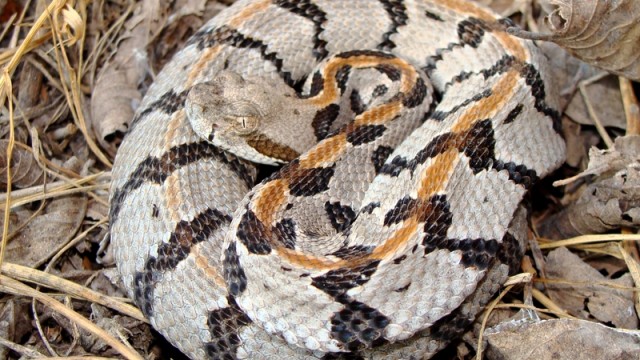The timber rattlesnake enjoys hanging out near houses and can sometimes be spotted crossing familiar roads. If you happen to spot a snake near your home or cabin this may be it!
Take time to familiarize yourself with its distinctive appearance. The color varies from light gray to yellow, and black chevron-shaped blotches hopefully will make it stand out more if you ever encounter one.
5 – Timber Rattlesnake
TIMBER RATTLESNAKE (Crotalus horridus). Length 3-4 feet, occasionally longer. The timber rattler occurs only in eastern Kansas and is only locally common, at scattered localities. It prefers the deciduous forest where Iimestone rock cutcrops as ledges, but may wander into cultivated fields and open areas during late spnng and summer. The food consists primarily of small rodents and young rabbits. Ordinarily, it is a mild-mannered snake, one which will seek to escape direct contact with man, but its size and habit of living close to human habitations necessitate considering this rattler dangerous. Ground color may vary from a light gray to yellow, with the black chevron-shaped blotches of the back uniting with lateral blotches to form crossbands. Another common name for the timber rattler is banded rattlesnake. Some individuals may be almost all black. The tail is characteristically velvet black in adults; banded in young.
During the spring and summer the timber rattler is quite often encountered crossing roads, where its large size and slow movement often make it a victim of modern transportation.
The timber rattler has a habit of frequently spending daylight time just beneath the edge of overhanging rocks. A hiker should always look beneath any rocks of this sort before using the rock as a resting place.
When out for a walk or a hike, remember this rattlesnake is often spotted near overhanging rocks. If you’re a rock climber or venture near rocky areas be vigilant.
The last snake on our list dwells mainly in the western U.S., and is one of the most common rattlesnakes. Since it’s common, take the time to memorize what it looks like. It’s especially important, since it’s known to be active during the daytime more than night time:


Yes Obama. Clinton,Schumer palosi. McCain, cnn
Well , they all look democRATS ,but they are so many of them it’s hard to identify them.
I can identify them only in soup or stews,they fast different .
#1 John mccain#2loretta lynch#3 Hillary clinton#4 jey johnson#6 Maxine Watters,#5obama#
Lynch,OBumer,Schumer ,Pelosie
–
Chuck Shumer
Nancy Pelosi
Elizabeth Warren
John McCain
Maxine Waters
Hillary Clinton
Nope
Guessing here…copperhead, water moccasin, and 2rattlesnakes…..one might be a sidewinder?
Dead snake!
The most important detail about snake bites is the statistic that the great majority of them occur because the victim tried to handle, or kill the snake. They’re easily as afraid of humans as we are them, so just leave them alone.